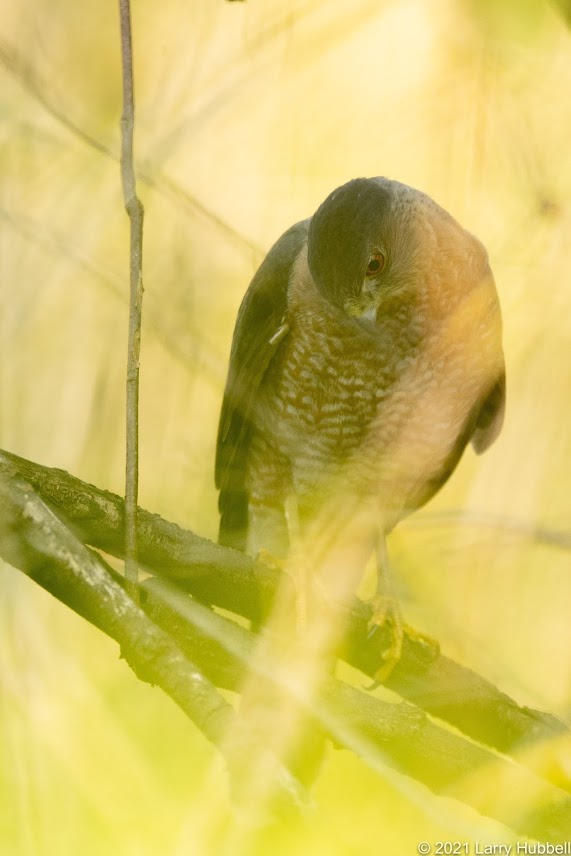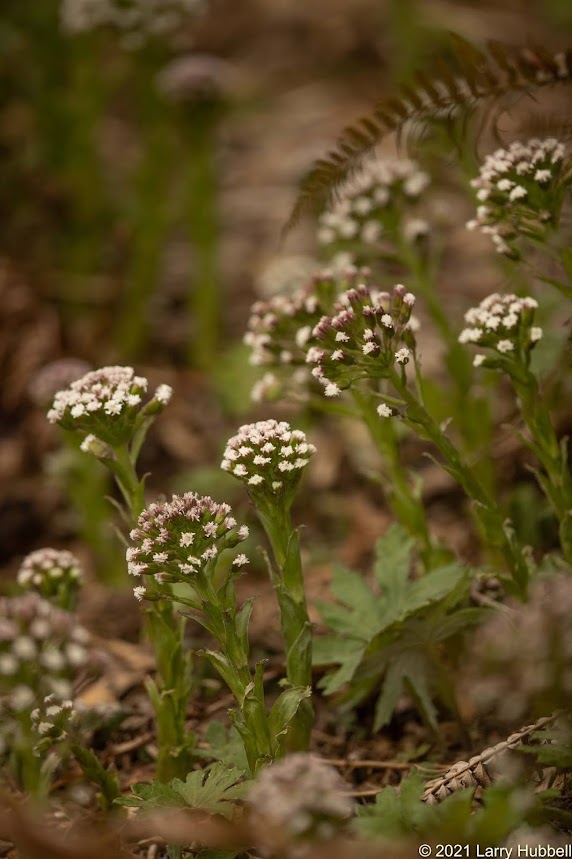A Cooper's Hawk is a raptor, but...
The simplest definition may be, "Raptors are meat-eating birds who use their talons to catch live creatures, except for Vultures & Condors, and use their curved bills to tear their food apart."
This definition requires the exception for carrion-eating birds since their food is not caught alive. The other raptors, who fit the definition quite well, are Eagles, Falcons, Hawks, Kites, Harriers, Ospreys, and Owls. Although, my Sibley guide does not explicitly label Owls as raptors.
Excluded from the category are birds like Herons, Cormorants, Grebes, Kingfishers, and others. They also catch and eat meat but they generally swallow their prey whole and do not normally rely on their feet to catch their prey.
Ravens and Crows are also excluded even though they do catch live prey. (Ravens are even intimidating enough to chase away raptors like Barred Owls and Red-tailed Hawks. Even so, they are raptor-like songbirds and not actually raptors.) I suspect they are excluded because they lack the extremely curved, meat-tearing bills, like raptors.
Speaking of these specialized bills, Does any other type of bird come to mind? If not, follow This Link to learn about a somewhat surprising avian relationship.
You may also want to visit the Urban Raptor Conservancy for another definition of raptors and information about their history in Seattle.
The hunting styles of raptors vary by species, individuals, and the specific opportunity. However, the most common approach, I have seen, is hunting from a perch.
Red-tailed Hawks often perch on light poles next to freeways and Bald Eagles often hang out in Cottonwood trees next to water. Both will leap from their perch and drop quickly to initiate flight just above the land or the water. They use their low elevation to help hide their approach and hope to catch their prey by surprise.
Merlins are small Falcons who can combine hunting from a perch with a surprisingly high-speed, terrain-hugging approach. They will suddenly appear, coming in horizontally, at full speed. In a split-second, they must decide to attack or avert. They do not have time to debate their choices and their prey often lacks time to escape.
Peregrine Falcons are also known for their speed. They are the fastest creatures on earth. Like many other raptors, they will often initiate attacks while soaring, e.g. circling on thermals. After obtaining a target they will pull in their wings and initiate a vertical dive - called a stoop.
Peregrines have unique physical gifts which enable them to handle the world-class pressure and speed that occurs during their diving attacks. They will use the same skills to hunt from highly elevated perches like cliff faces and, in our modern world, from skyscrapers.
Some raptors, also employ a less impressive, more parasitic, hunting technique. When a Bald Eagle spots a smaller bird with desirable food it will often give chase. Being weighed down, and considerably slower than normal, the smaller bird will usually give up the food in order to escape with its life. The Gull in this photo even regurgitated the large strip of salmon, to ensure its survival.
Barred Owls also hunt from perches although they generally work below a canopy of trees and often under the cover of darkness. They depend on shadows, silence, surprise (and excellent eyes) more than speed.
Another approach, used by Harriers and Short-eared Owls is to continuously circle above a field of short vegetation. Their method of surprise is to silently appear immediately overhead and abruptly drop on their prey.
This week, I observed another hunting style, one which reminds me of a Cougar silently stalking Deer in a forest.
I was in the southern part of the Arboretum in the same area referred to in last week's post. Suddenly, an American Robin rose up from the ground and made a high-speed break to the southwest. It barely skimmed above the Sword Ferns, Salal, and Indian Plums. A moment later, another left the same area with the same urgency and trajectory. Almost immediately, two more followed on parallel paths.
Normally, when American Robins are flushed by humans, they will simply fly up to a nearby perch and calmly wait for the person to pass. Often, they may even return to the same location and resume feeding. These birds behaved quite differently. They flew as fast as possible and gained minimal elevation. They were wasting no time while avoiding a serious threat.
My immediate thought was a Barred Owl or a Cooper's Hawk. I saw nothing moving through the branches. Plus, since Barred Owls normally hunt at night, I began scanning the underbrush to the northeast for a Cooper's Hawk, although a Coyote would have been another logical possibility. I saw no movement and heard no sounds, which implied the approaching predator had experience and skill.
A moment later, this Cooper's Hawk silently rose from the ground and perched on a low branch partially hidden among the Indian Plums.
It continued to search the ground, no doubt, hoping to catch a small creature by surprise. (The orange barring on its chest indicated it was a mature bird.)
It looked to the left and right while ignoring me and my daughter's dog Ginger, before flying a few feet to the west.
On its new perch, it continued the search. In this area, I have seen ground-nesting Dark-eyed Juncos and Spotted Towhees, as well as Varied Thrush, turning leaves for food, and Northern Flickers on nearby trees - all in addition to the American Robins.
Any of the above would fit the bill as a meal for a hungry hawk.
At a fork in the Cottonwood above the bird's head is an Eastern Gray Squirrel's nest. They may seem a bit large but a Cooper's Hawk however the small Hawks tend to fight above their weight class. Plus, the native Douglas Squirrels, which are smaller, also frequent this area.
A small shiver seemed to overtake the Cooper's Hawk.
By the way, the dark "cap" on the bird's head is one way to distinguish it from a Sharp-shinned Hawk.
It looked over its shoulder most likely focused on a sound outside of my range...
...before continuing to search the ground below.
Click Here to read a post that provides examples of Cooper's Hawks walking, hopping, or crawling through vegetation in search of food. The only other raptor, I remember watching, with a similar method of hunting is a Sharp-shinned Hawk. Since they are basically a small convergent-evolutionary version of a Cooper's Hawk, it is not surprising that they utilize similar tactics.
The Cooper's Hawk orange iris is another sign of maturity.
Juveniles have light-colored irises. Although, the vertical stripes and dark little teardrops on their chests are a much more obvious sign of their youth.
I am pleased to say the Cooper's Hawk continued to hunt unperturbed by our presence.
Sadly, for the Cooper's Hawk, but happily for all the local prey species, it failed to find food while we watched.
On its next stop to the south, the Cooper's Hawk rose up to a higher perch. Perhaps, it was looking for movement in the vegetation before zooming back down to resume its "hands-on" approach to hunting.
When we remove trees and bushes and expand lawns in our yards and parks we remove habitat, food sources, potential nest sites, and cover for many small creatures. Certainly. lawns have value for many human activities. However, allowing trees and bushes to grow, or even just letting the grass grow to maturity provides cover and seeds, that can significantly help small creatures and birds. Helping them will in turn enable the continued survival of small urban raptors.
For me, during this last year, nature in the city has sustained my soul. Observing nature has helped me to maintain both my mental and physical health. More bushes and trees, along with less cleanly mowed grass in the city, may not save the planet. However, if the next generation grows up experiencing nature next door they will, at least, have a personal understanding of the choices they face.
Have a great day on Union Bay...where nature lives in the city and Black Birders are welcome!
Larry
Going Native:
Each of us, who breathe the air and drink the local water, needs to watch and protect our local environment. Native plants and trees encourage the largest diversity of lifeforms because of their long intertwined history with our local environment and native creatures. I have been told that even the microbes in the soil are native to each local landscape. I hope we can inspire ourselves, our neighbors, and local businesses to respect native flora and to support native wildlife at every opportunity. I have learned that our most logical approach to native trees and plants (in order of priority) should be to:
1) Learn and leave established native flora undisturbed.2) Remove invasive species and then wait to see if native plants begin to grow without assistance. (If natives plants start on their own, then these plants or trees are likely the most appropriate flora for the habitat.)3) Scatter seeds from nearby native plants in a similar habitat.4) If you feel you must add a new plant then select a native plant while considering how the plant fits with the specific habitat and understanding the plant's logical place in the normal succession of native plants.
My intention in my weekly post is to include at least one photo each week and visually challenge us to know the difference between native and non-native lifeforms.
Also, Jane Lundin has created a small package, with a lot of critical information that looks quite handy, and light, for backpacking in the mountains in Springtime. It is titled, Mountain Wildflowers of Washington.)
Scroll down for the answer.
***************
Coltsfoot: On the positive side it is a native plant that loves well-watered locations. On the other hand, it apparently spreads, even underground, and can completely take over.
This small Western Red Cedar was cut to provide more light. The Coltsfoot has seized the opportunity and clearly colonized the previously protected area.
*****************
The Email Challenge:
In response, I have set up my own email list. Each week, I manually send out a new post announcement. If you would like to be added to my personal email list please send me an email requesting to be added. Something like:
Larry, I want to see more of nature. Please add me to your personal email list.
Thank you for your patience and interest!
One more photo:
My email address is: LDHubbell@Comcast.Net
*******************

























No comments:
Post a Comment